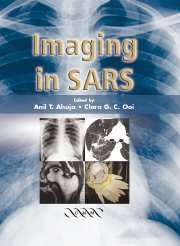Book contents
- Frontmatter
- Contents
- Contributors
- Preface
- 1 The Epidemiology of Severe Acute Respiratory Syndrome: A Global Perspective
- 2 The Role of Emergency Medicine in Screening SARS Patients
- 3 Severe Acute Respiratory Syndrome Outbreak in a University Hospital in Hong Kong
- 4 Imaging of Pneumonias
- 5 The Role of Chest Radiographs in the Diagnosis of SARS
- 6 Chest Radiography: Clinical Correlation and Its Role in the Management of Severe Acute Respiratory Syndrome
- 7 The Role of High-Resolution Computed Tomography in Diagnosis of SARS
- 8 The Role of Imaging in the Follow-up of SARS
- 9 Treatment of Severe Acute Respiratory Syndrome
- 10 SARS in the Intensive Care Unit
- 11 Imaging of Pneumonia in Children
- 12 Imaging and Clinical Management of Paediatric SARS
- 13 Imaging of SARS in North America
- 14 Radiographers' Perspective in the Outbreak of SARS
- 15 Implementation of Measures to Prevent the Spread of SARS in a Radiology Department
- 16 Aftermath of SARS
- 17 Update on Severe Acute Respiratory Syndrome
- Index
13 - Imaging of SARS in North America
Published online by Cambridge University Press: 27 October 2009
- Frontmatter
- Contents
- Contributors
- Preface
- 1 The Epidemiology of Severe Acute Respiratory Syndrome: A Global Perspective
- 2 The Role of Emergency Medicine in Screening SARS Patients
- 3 Severe Acute Respiratory Syndrome Outbreak in a University Hospital in Hong Kong
- 4 Imaging of Pneumonias
- 5 The Role of Chest Radiographs in the Diagnosis of SARS
- 6 Chest Radiography: Clinical Correlation and Its Role in the Management of Severe Acute Respiratory Syndrome
- 7 The Role of High-Resolution Computed Tomography in Diagnosis of SARS
- 8 The Role of Imaging in the Follow-up of SARS
- 9 Treatment of Severe Acute Respiratory Syndrome
- 10 SARS in the Intensive Care Unit
- 11 Imaging of Pneumonia in Children
- 12 Imaging and Clinical Management of Paediatric SARS
- 13 Imaging of SARS in North America
- 14 Radiographers' Perspective in the Outbreak of SARS
- 15 Implementation of Measures to Prevent the Spread of SARS in a Radiology Department
- 16 Aftermath of SARS
- 17 Update on Severe Acute Respiratory Syndrome
- Index
Summary
Introduction
The first diagnosis of severe acute respiratory syndrome (SARS) in North America was made in Toronto on 13 March 2003. This was the first recognized case of the disease outside of Asia. By 2 June, 198 cases of probable SARS were reported in Canada, 30 (15%) of whom had died. In the US at the same time 66 cases of probable SARS had been reported, none of whom had died.
The first patient with SARS in North America was a 78-year-old woman who returned home to Toronto on 23 February 2003 after a visit to relatives in Hong Kong. Two days later she developed fever, myalgia, sore throat and mild non-productive cough. Five days later she developed increasing cough and dyspnoea. She died 3 days later, on 5 March, at home, 9 days after the onset of her illness. The diagnosis of SARS was only made in retrospect.
The index patient's 43-year-old son developed fever and sweating on 27 February, 2 days after his mother first noted the symptoms. He subsequently developed non-productive cough, chest pain, and dyspnoea and eventually high fever (temperature, 39.8°C).
A chest radiograph revealed bilateral lower lobe consolidation. He was admitted to the hospital with a diagnosis of community-acquired pneumonia. On the 2nd day after admission, he developed respiratory failure, was intubated and received mechanical ventilation.
- Type
- Chapter
- Information
- Imaging in SARS , pp. 131 - 142Publisher: Cambridge University PressPrint publication year: 2004

